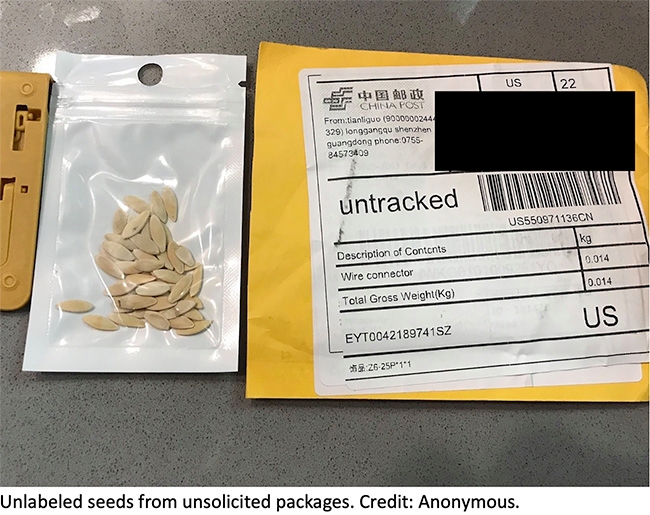
Posts Tagged: seed
USDA Investigating Packages of Mysterious Seeds
Have you had unexpected seeds show up in the mail? Unknown seeds could be invasive plants, contain invasive insects, or have plant disease causing agents. Here's what the United States Department of Agriculture Animal Plant and Health Inspection Service (USDA APHIS) has to say about it.
USDA Investigates Packages of Unsolicited Seeds
USDA is aware that people across the country have received suspicious, unsolicited packages of seed that appear to be coming from China. USDA's Animal and Plant Health Inspection Service (APHIS) is working closely with the Department of Homeland Security's Customs and Border Protection, other federal agencies, and State departments of agriculture to investigate the situation.
USDA urges anyone who receives an unsolicited package of seeds to immediately contact their State plant regulatory official or APHIS State plant health director. Please hold onto the seeds and packaging, including the mailing label, until someone from your State department of agriculture or APHIS contacts you with further instructions. Do not plant seeds from unknown origins.
At this time, [USDA does not] have any evidence indicating this is something other than a “brushing scam” where people receive unsolicited items from a seller who then posts false customer reviews to boost sales. USDA is currently collecting seed packages from recipients and will test their contents and determine if they contain anything that could be of concern to U.S. agriculture or the environment.
USDA is committed to preventing the unlawful entry of prohibited seeds and protecting U.S. agriculture from invasive pests and noxious weeds. Visit the APHIS' website to learn more about USDA's efforts to stop agricultural smuggling and promote trade compliance.
Weed Seeds and Their Longevity
From the UC Weed Science Blog
//ucanr.edu/blogs/UCDWeedScience/
A repost and link today to a recent Weed Science Society of America press release entitled: "About Weed Seeds and Their Longevity" Click the link to go to the full article.
An excerpt from the press release and links to the free download:
Did you know some weed seeds can lie dormant in the soil for more than a century and then sprout when conditions are right? A new factsheet available for free download from the Weed Science Society of America (WSSA) dives into the topic of weed seed longevity, as well as how weed seeds travel, when and why they germinate, and ways they can be eliminated.
“Understanding weed seeds and their lifespan is critical for both farmers and backyard gardeners alike,” says WSSA member Greta Gramig, Ph.D., associate professor of weed science at North Dakota State University. “Seeds can remain viable in the soil for extended periods of time. That means if even a single weed is allowed to go to seed, you may be battling the aftermath for years to come.”
Here are just a few of the many facts about weed seeds that are covered in the new WSSA fact sheet:
- Moth mullein seeds buried by a researcher in 1879 were still able to germinate more than 130 years later.
- Weed seeds can easily be spread and transported far from their original location. Some have found their way into the earth's planetary boundary.
- Earthworms are known to collect weed seeds and move them into their burrows.
- Weed seeds that remain dormant in the soil will often germinate in response to changes in temperature, moisture, oxygen or light.
- Carabid beetles are voracious eaters and can consume large quantities of weed seeds that drop to the soil.
In addition to its fact sheet on weed seeds, WSSA offers a variety of other free fact sheets and educational materials online, including infographics and presentations on herbicide resistant weeds and their management.

weeds
The Case for Attacking Weeds Before They Start Setting Seed
One point I always make is that the sooner you control annual weeds, the better. This reduces crop-weed competition, along with a host of other issues caused by weeds (we'll save that for another blog). But the real key to forward-looking weed management is to kill the weed before it produces seeds. Once seeds are produced, they contribute to the seed bank, pretty much ensuring that the weed population will be a continual problem.
But suppose you miss some weeds that are starting to flower but the flowers aren't open yet? I think most growers will just pull or cut the weed and leave it in or near the field.
I want to show you a time-lapse video I took. I cut the flowering stem off of an annual sowthistle plant and took a photo with a special camera every minute for 6 days. As you can clearly see, even though the stem was no longer receiving water or nutrients from the soil, at least the flower bud continued to mature and produce seeds. Now, having said that, I have not germinated the seeds to see if they are viable, but there is a good chance they are. Click HERE for video. It's about 1 1/2 minutes long, but most of the action happens in the first 50 seconds.
So the take home message - if the weeds have flower buds starting to open, remove them to covered piles, trash cans, or other area where they will not be a source of new weed seeds.

sowthistle

